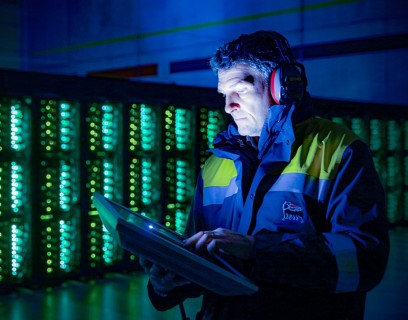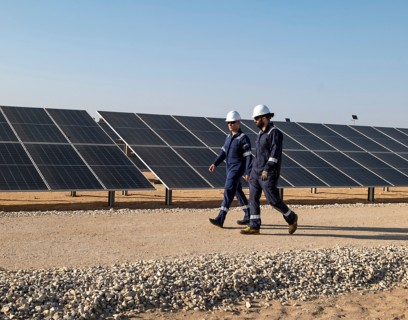
Oppure , la nostra nuova soluzione di intelligenza artificiale.
Oppure , la nostra nuova soluzione di intelligenza artificiale.
Accedi a MyEni
Energia solare termica
Abbiamo sviluppato una tecnologia del solare a concentrazione più evoluta per produrre energia termica in modo più efficiente, economico e versatile.

Che cosa è il solare a concentrazione
I sistemi ad energia solare termica usano la fonte rinnovabile del sole per produrre calore. Per raggiungere elevate temperature necessarie in ambito industriale o per la generazione di energia elettrica, è necessario moltiplicare la potenza del sole attraverso sistemi a concentrazione. La configurazione più consolidata del solare a concentrazione (Concentrating Solar Power – CSP o Concentrating Solar Thermal – CST) consiste in specchi parabolici che riflettono e concentrano i raggi del sole in un unico punto, detto fuoco, accumulando calore fino a raggiugere temperature anche oltre i 500°C; questo calore può essere utilizzato per produrre energia termica o elettrica in modo rinnovabile.
Il sistema è utilizzato fin dai tempi antichi, ma nel Centro di Ricerca Eni di Novara abbiamo sviluppato nuove soluzioni che ne riducono i costi di produzione aumentandone la semplicità e la versatilità e, di conseguenza, le possibilità di utilizzo in svariati contesti. Tutto ciò mantenendo elevata efficienza ottica e termica.

Pilota
Energia termica
Energia elettrica
Politecnico di Milano
MIT - Massachusetts Institute of Technology di Boston
A cosa serve
L’energia termica prodotta con la tecnologia CSP può essere utilizzata all’interno di cicli produttivi che richiedono processi di riscaldamento, per produrre vapore da utilizzare direttamente oppure per muovere una turbina e produrre elettricità. Il principio era noto già ai tempi di Archimede ed è applicato a livello industriale dagli anni Settanta del Novecento. Nei laboratori Eni, in collaborazione con il Politecnico di Milano e l’MIT di Boston, abbiamo messo a punto le nuove soluzioni tecnologiche, attualmente in sperimentazione a Gela, per valutarne le possibilità applicative.
Come funziona
I raggi solari vengono concentrati dagli specchi parabolici lineari su un tubo - detto ricevitore - posto nel fuoco geometrico della parabola e nel quale scorre un fluido termovettore (ovvero in grado di immagazzinare e trasportare calore). Tale calore, grazie a uno scambiatore, può essere utilizzato nei processi industriali o impiegato per generare vapore. Il vapore, a sua volta, può far girare una turbina e produrre energia elettrica.
Per rendere più efficiente il sistema, siamo intervenuti su quattro elementi: lo specchio, il rivestimento del tubo ricevitore, il fluido termovettore e la struttura di sostegno. Per la superficie riflettente abbiamo scelto una speciale pellicola in PET e argento molto più leggera, robusta ed economica degli specchi tradizionali in vetro. Il tubo in cui scorre il fluido lo abbiamo realizzato in multistrato di acciaio e ceramica con proprietà termiche ottimizzate. Per il fluido abbiamo puntato su una miscela di sali fusi che solidifica a temperature molto inferiori rispetto a quella dei fluidi utilizzati fino ad ora consentendogli di scorrere in un maggiore intervallo di temperature. Infine, nel design complessivo abbiamo adottato le soluzioni strutturali più semplici possibili.
Caratteristiche e prestazioni
-
100-150°C
punto di solidificazione del fluido (vs ~250°C per i fluidi tradizionali) ¹
-
95%
assorbanza del tubo in cui scorre il fluido ²
-
7%
emissività del tubo (a 550°C) ²
- (1) Una minor temperatura di solidificazione del fluido termovettore ci permette di tenerlo in circolo a temperature più basse durante le ore notturne diminuendo sensibilmente le perdite termiche del sistema.
- (2) Maggiori assorbanze e minori emissività del tubo ricevitore, permettono di sfruttare in modo più efficiente la radiazione solare e di costruire quindi campi solari di dimensioni ridotte con risparmi anche notevoli sui costi di realizzazione dell’intero sistema.
Partner tecnologici
Altre possibilità nel solare
La ricerca Eni ha anche studiato soluzioni per utilizzare l’energia del sole integrando i sistemi direttamente nelle facciate, negli infissi degli edifici o nelle infrastrutture. In particolare, ci siamo dedicati al fotovoltaico organico (Organic PhotoVoltaic - OPV), pellicole fotoattive sottili come carta di giornale, e ai concentratori solari luminescenti (Luminescent Solar Concentrators – LSC), lastre trasparenti colorate in grado di catturare la luce diffusa e concentrarla ai bordi dove, grazie a strisce di materiale fotovoltaico, viene convertita in elettricità.



















